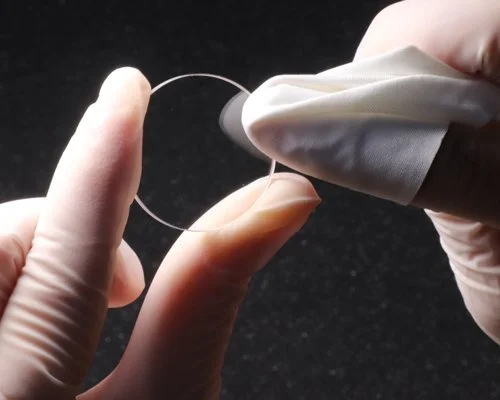Optical Windows
Optical windows are transparent components made of materials like glass or crystal that are used to protect and control the flow of light in optical systems. IR windows and optics for use in FTIR Spectroscopy and CO2 lasers. This includes discs, rectangular plates and various other geometries.
In various fields, optical windows serve many purposes. They act as protective barriers, shielding sensitive optical components from environmental factors such as dust, moisture, and contaminants. Additionally, they enable the transmission of light while minimizing distortion, reflection, and absorption, thus maintaining the integrity of the optical system.
Optical windows are employed in a wide range of applications, including scientific research, industrial manufacturing, aerospace, defense, and telecommunications. They are utilized in optical instruments like cameras, microscopes, telescopes, lasers, and sensors. By providing a stable optical interface, optical windows facilitate accurate measurements, imaging, and analysis of light, enabling advancements in numerous fields.
Optical windows come in many shapes and sizes but a major factor is their material. The types of materials that an optical window is constructed from dictate the wavelengths (measured in nm) that they can view. In IR It is extremely important that selecting the right material is done to avoid many a headache and a waste of money and time.
If you are having choice fatigue and are getting overwhelmed by all the options please check out our optical window guide.
Potassium Bromide (KBr) Windows
Potassium Bromide (KBr) Windows
Potassium Bromide (KBr) is commonly used in FTIR spectroscopy and is mostly sought for its excellent transmission range from the UV to the long IR range. KBr is similar to Sodium Chloride (NaCl) but has a slightly expanded spectral range.
KBr is water soluble and must be used in a moisture-free environment as the polished surfaces will degrade in a moist atmosphere. These windows provide good resistance to mechanic shock and can be used in high temperatures (up to 300ºC).
Firebird provides these in several uncoated stock configurations but can provide customized and coated to your specifications.
Potassium Bromide Windows: An Overview
Potassium bromide (KBr) windows are commonly used in Fourier-transform infrared spectroscopy (FTIR) and other spectroscopic applications. They are made from a high-purity KBr crystal and have excellent optical properties, including high transmission in the infrared region. In this article, we will provide an overview of KBr windows, including their properties, uses, and maintenance.
Properties of KBr Windows
KBr windows have several properties that make them suitable for spectroscopic applications. These include:
High transmission: KBr windows have high transmission in the infrared region, allowing for accurate measurements.
Low refractive index: KBr has a low refractive index, reducing the amount of reflection at the window surface.
Chemically stable: KBr is chemically stable and resistant to most acids and bases, making it suitable for use in harsh environments.
Easy to manufacture: KBr windows are relatively easy to manufacture and can be produced in large quantities.
Uses of KBr Windows
KBr windows are commonly used in FTIR spectroscopy, where they are placed in the sample compartment of the instrument. They are also used in other spectroscopic techniques, such as Raman spectroscopy and infrared microscopy. KBr windows are particularly useful in applications that require high transmission in the infrared region, such as the analysis of organic compounds.
Maintenance of KBr Windows
To maintain the optical properties of KBr windows and ensure accurate measurements, it is important to clean them regularly. KBr windows are sensitive to water and other chemicals, so care must be taken when cleaning them. It is recommended to use a microfiber cloth or lens tissue dampened with isopropyl alcohol or acetone to clean KBr windows. Avoid using water, as it can react with the KBr and cause cloudiness or etching. It is also important to store KBr windows in a clean, dust-free environment to prevent contamination.
Conclusion
KBr windows are an important component of spectroscopic instrumentation, providing high transmission in the infrared region and excellent optical properties. Regular maintenance is important to ensure accurate measurements and prolong the lifespan of KBr windows. By following best practices for cleaning and storage, KBr windows can provide reliable and accurate measurements for years to come.
KBr Specs:
| Wavelength range: 250-26µm | Coating: Uncoated |
|---|---|
| Diameter tolerance: ±0.5mm | Surface Quality: 60/40 |
| Thickness tolerance: ±0.2mm | Paralellism: <5 arc minute |
| Clear Aperture: 90% | Density: 2.753g/cm3 | Melting point: 728ºC | Young's Modulus: (GPa): 26.8 | Coefficient of Thermal Expansion: 43 x 10-6/°C | Knoop Hardness: 7kg/mm2 |









Finding the right optical window can be an exercise in choice fatigue. Let us help!